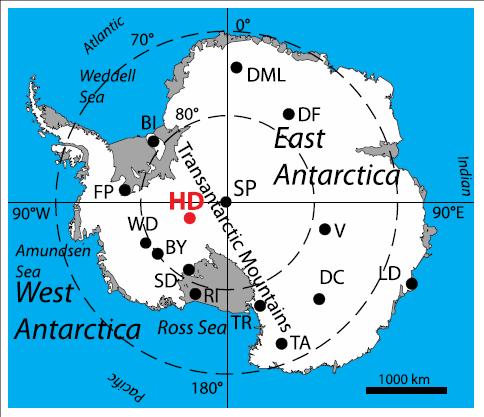
Credit: University of Washington
Antarctica’s next deep ice core, drilling down to ice from 130,000 years ago, will be carried out by a multi-institutional U.S. team at Hercules Dome, a location hundreds of miles from today’s coastline and a promising site to provide key evidence about the possible last collapse of the West Antarctic Ice Sheet.
The National Science Foundation has funded the roughly five-year, $3 million project involving the University of Washington, the University of New Hampshire, the University of California, Irvine and the University of Minnesota. Work has been delayed by the novel coronavirus, but drilling the 1.5-mile ice core likely will begin in 2024.
“The ice at this site goes back to a time when sea level was about 6 meters (20 feet) higher than it is now,” said project leader Eric Steig, a UW professor of Earth and space sciences. “One of the most likely reasons that sea level was higher is that a large area of Antarctic, known as the West Antarctic Ice Sheet, was gone.”
Scientists hope to understand the most recent collapse of the West Antarctic Ice Sheet in order to better gauge its potential risk in today’s warming climate. Deeper ice layers at this site reach back to Eemian times — the most recent period that, like now, was between ice ages. The Eemian was even warmer than today’s climate and oceans were higher.
“This location, which is now hundreds of miles from the ocean, may have been waterfront property 125,000 years ago,” Steig said. “We should be able to determine this from the chemistry of the ice — for example, the salt concentration may be higher if there was open water nearby, instead of more than a thousand miles away. Understanding that event will help guide our understanding of how quickly sea level may rise in the future due to ongoing anthropogenic climate change.”
The Hercules Dome site, remote even by Antarctic standards, lies near a mountain range that divides East and West Antarctica. UW researchers visited the site in early 2020 to survey potential locations for drilling. They used ice-penetrating radar to find places where the layers of ice are uninterrupted back more than 125,000 years, when oceans rose dramatically.
Ice and air bubbles trapped in the ice layers can provide researchers with various information about past conditions The most recent deep ice core in Antarctica was completed in 2016 at the South Pole by many of the same team members.
“The Hercules Dome ice core will be the first U.S. ice core with the potential to yield a detailed climate record during the last interglacial period,” said principal investigator Murat Aydin at the University of California, Irvine.
The project will begin with online workshops over the next year to seek new collaborators and work to broaden participation in polar science. The initial investment by the National Science Foundation covers the costs of the drilling project, but over the next few years, many more scientists can seek additional funding to analyze the core. The delays caused by the pandemic offer more time to try to bring new people into the discipline.
“Earth sciences is known for being particularly white and male, and polar Earth sciences is even more that way,” Steig said. “It’s well established that having a more diverse community leads to better outcomes — that is, we’ll do better science with more kinds of people involved. But also it’s the right thing to do. Anyone who is interested in being involved in this science should have the opportunity to do it.”
The University of New Hampshire will provide logistics and science support planning for the field project. Researchers will live in tents on the ice sheet hundreds of miles from any inhabited areas for the months-long field seasons.
“Our planning will detail, for example, how we will get ourselves and all of the required science cargo and camp materials to Hercules Dome, likely through a combination of overland traverse and aircraft support; specifics on the field camp, such as camp population, camp structures and layout, power and fuel requirements, camp equipment; and the fieldwork schedule,” said Joe Souney, research project manager at the University of New Hampshire.
The project has plans to coordinate with artists, computer scientists, media outlets, educational organizations and museums to share the effort and the science of climate change.
Heidi Roop, a climate scientist at the University of Minnesota, will lead the engagement programming and will work to connect the science through this project to different audiences including those who are actively planning and preparing for the impacts sea level rise — from coastal planners and water utility engineers to homeowners and elected officials.
“This is the first U.S. deep ice core drilling project with a lead researcher dedicated to the integration of community engagement and communication across the full lifespan of the project,” Roop said. “With this investment by NSF, we are confident we can more effectively connect this science to action.”
###
For more information, contact Steig at [email protected], Aydin at [email protected], Souney at [email protected] and Roop at [email protected]
More information about the project is at http://www.
Media Contact
Hannah Hickey
[email protected]
Original Source
https:/
https://scienmag.com/nsf-funded-deep-ice-core-to-be-drilled-at-hercules-dome-antarctica/




